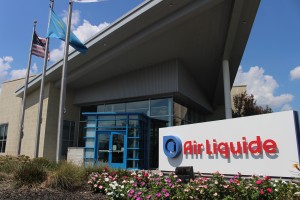>> Article by Guest Writer, Delaware Business Journal, August 29, 2022
This week, Air Liquide was proud to host at our Innovation Campus Delaware (ICD) U.S. Secretary of Energy Jennifer Granholm, U.S. Secretary of Labor Marty Walsh, Senators Tom Carper and Chris Coons, Rep. Lisa Blunt Rochester, and Governor John Carney for a productive discussion of our nation’s energy future and the key role that hydrogen will play in decarbonizing some of our most carbon intensive industries.
Following the signing of the Inflation Reduction Act (IRA) into law by President Biden, the United States is in a stronger position than ever to strengthen its domestic hydrogen market to the benefit of our environment and economy. The energy tax provisions included in the new law send a strong market signal that the United States is serious about hydrogen’s role in driving a clean energy transition, incentivizing continued private sector investment and increased hydrogen production.
It is important to note that the technologies for hydrogen exist today. Alongside programs like the U.S. Department of Energy’s (DOE) Hydrogen Hub program, we are now poised to make real progress on the regional and localized deployment of hydrogen technologies and infrastructure across the country. In doing so, we will be able to make hydrogen more accessible and affordable for consumers across the economic spectrum looking to curb their carbon footprints.
Hydrogen provides the flexibility and reliability needed to achieve a true clean energy transition swiftly and effectively. Indeed, it can decarbonize our transportation and industrial sectors – which are the source for the majority of our nation’s greenhouse gas (GHG) emissions – and facilitate the onboarding of more renewable energy on the electric, and can serve as critical, scalable energy storage.
In addition to its environmental benefits, the development of a strong domestic hydrogen market will support the growth of our economy and create critical new clean energy jobs for American workers. According to a recent McKinsey report, a mature domestic hydrogen market stands to deliver an estimated $140 billion per year in revenue and 700,000 new jobs across the hydrogen value chain by 2030.
Globally, by 2050, the global hydrogen economy could avoid 6 gigatons of carbon dioxide emissions, create a $2.5 trillion market for hydrogen and fuel cell equipment, and provide sustainable employment for more than 30 million people.
Simply put, hydrogen is proof that our environment and economy can grow hand-in-hand.
It is no coincidence that this week’s discussion on our energy future took place in Delaware. The state has an impressive and inspiring history as a bastion for American innovation. From medicine to aerospace to defense and technology, so much of the R&D that has progressed our economy, society, and modern way of life has links to Delaware’s universities, corporations, and entrepreneurs.
In fact, it is this legacy that drove Air Liquide’s decision 15 years ago to establish the Innovation Campus, the anchor of research and development for the Americas, in Newark. We saw clearly that Delaware’s commitment to innovation matched our own. Today, the ICD signifies a $100 million investment in innovation and the advanced technologies that will change the future, like hydrogen for the clean energy transition, working in partnership with entities like DOE and the University of Delaware.
The R&D conducted at the ICD supports the cutting-edge technology that Air Liquide deploys in its operations, in support of the development of the U.S. hydrogen market and the achievement of our national and global environmental goals.
In partnership with DOE, the ICD is currently focused on demonstrating the first-of-its-kind hydrogen refueling infrastructure for maritime applications, developing an integrated approach for sustainable steelmaking, solving the technical challenges of blending hydrogen in natural gas pipelines, and enhancing the technology of high-density hydrogen energy storage. And that’s but a fraction of the exciting work underway.
As we look forward to the promise of emerging technologies and the next phase of our nation’s energy landscape, it is essential that we have the right public policies in place to support further investment and commitment. To-date, Air Liquide has invested more than $1 billion into hydrogen in the U.S., and we are committed to investing another $10 billion globally in the entire low-carbon hydrogen value chain by 2035.
The energy tax provisions of the IRA send a strong signal that the United States takes hydrogen’s role in our clean energy future seriously, and is an example of the smart climate policy needed to make that future a reality.
>>> Adam Peters is the CEO of Air Liquide North America
#######+++++++#######+++++++########
Hindenburg Disaster: Real Zeppelin Explosion Footage
(1937 …
Video here ~ https://youtu.be/CgWHbpMVQ1U

